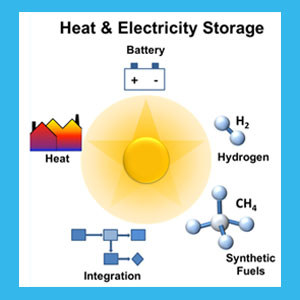Speaker
Dr
Abhijit Dutta
(Department of Chemistry and Bio-chemistry, University of Bern)
Description
Synthesis of SnO2 nano particles on PVP functionalized reduced graphene oxide by self-capping function of hexanoate ligands: An application for electrochemical CO2 reduction in aqueous medium
Abhijit Dutta, Motiar Rahaman,Thomas Wandlowski, Peter Broekmann
Department of Chemistry and Bio-chemistry, University of Bern, Freiestrasse 3, 3012 Bern, Switzerland
Abstract:
The increase of carbon dioxide (CO2) in the atmosphere is asserted to be one of the major suppliers to the greenhouse effect. The electro-catalytic reduction of CO2 to liquid fuels is a critical goal that would positively impact the global carbon balance by recycling CO2 into usable fuels.
To address this challenging scientific problem, we need to advance our fundamental understanding of the chemistry of CO2 activation and develop novel multifunctional catalysts that could use electricity to efficiently break C-O bond and form C-H and C-C bonds. An appropriate energy input and reasonable productivity of fuels are also important considerations for practical industrial processes. There are many heterogeneous catalytic processes in energy conversion and storage systems possess necessary surface active sites of the catalysts matrix in an efficient way. Here, we synthesized SnO2 nano particles having 5–8 nm in size on polyvinylpyrrolidone (PVP) functionalized reduced graphene oxide via a non-hydrolytic solvothermal reaction with hexanoate complexes. PVP is used to stabilize graphene sheets in solution and prevent their aggregation. The dissociated hexanoates ligand on the metals, working as a capping agent, induces the size control of the nano-particles during the synthesis. The synthesized nanoparticles are soluble in a non-polar solvent and can also be form a transparent suspension in an aqueous solution by converting the capping group to a citrate. The surface morphology of the catalysts is determined by XRD (X-ray diffraction), TEM (transmission electron microscopy) and XPS (X-ray photoelectron spectroscopy) analysis. XRD patterns reveal that all the catalysts have disordered cassiterite in structures. Low resolution TEM images reveal uniform dispersion of SnO2 nano particles on reduced graphene nano sheet having an average size of 5-8 nm. The X-ray photoelectron spectroscopy revel the charge density redistribution via the nano-scale formation of SnO2 nano-particles and rGO which is paramount to import surface active sites. The composite materials are electrochemically characterized by cyclic-voltammetry (CV), linear sweep voltammetry (LSV), and chronoamperometry (CA) in CO2 saturated 0.5M NaHCO3 medium.
Reference:
1. W. Li, et. al, ACS Symposium Series, Chapter 5, pp 55–762.
2. J. Qiao et.al. . Chem. Soc. Rev. 00, (2013) 1
3. A. Dutta, et.al, Applied Catalysis B, 158–159 (2014) 119–128
Author
Dr
Abhijit Dutta
(Department of Chemistry and Bio-chemistry, University of Bern)
Co-authors
Mr
Motiar Rahaman
(Department of Chemistry and Bio-chemistry, University of Bern)
Dr
Peter Broekmann
(Department of Chemistry and Bio-chemistry, University of Bern)
Prof.
Thomas Wandlowski
(Department of Chemistry and Bio-chemistry, University of Bern)

